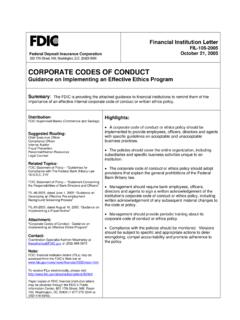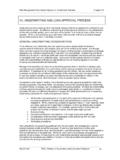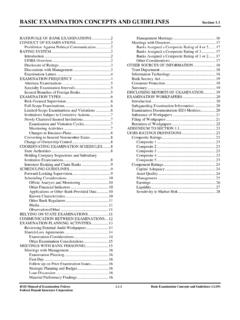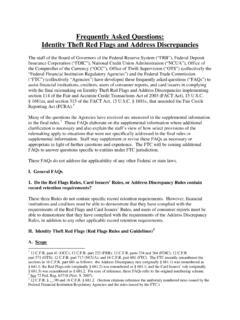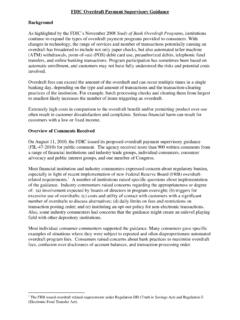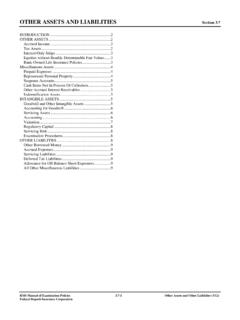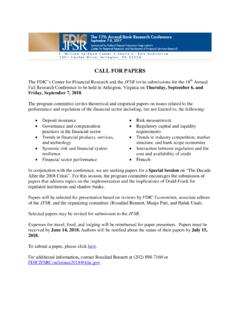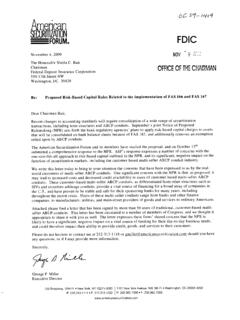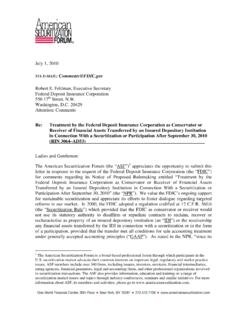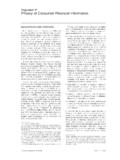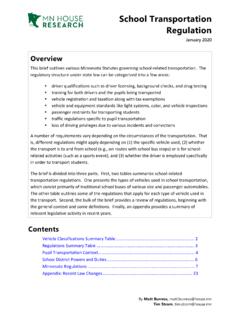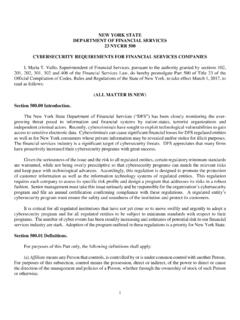Transcription of 4-5 Introduction to the Federal Acquisition Regulation
1 A basic Introduction to the regulations governing the Federal Acquisition process Introduction to the Federal Acquisition Regulation (FAR) At the end of this module, you will be able to: Identify what is in the Federal Acquisition Regulation (FAR). Understand how to use the FAR. Be prepared to follow the rules and regulations governing small businesses. Doing so may prevent costly errors and legal problems. Learning Objectives 2 FDIC OMWI Education Module: Introduction to the FAR The Federal Deposit Insurance Corporation (FDIC) recognizes the important contributions made by small, veteran, and minority and women-owned businesses to our economy. For that reason, we strive to provide small businesses with opportunities to contract with the FDIC. In furtherance of this goal, the FDIC has initiated the FDIC Small Business Resource Effort to assist the small vendors that provide products, services, and solutions to the FDIC.
2 The objective of the Small Business Resource Effort is to provide information and the tools small vendors need to become better positioned to compete for contracts and subcontracts at the FDIC. To achieve this objective, the Small Business Resource Effort references outside resources critical for qualified vendors, leverages technology to provide education according to perceived needs, and offers connectivity through resourcing, accessibility, counseling, coaching, and guidance where applicable. This product was developed by the FDIC Office of Minority and Women Inclusion (OMWI). OMWI has responsibility for oversight of the Small Business Resource Effort. About FDIC Small Business Resource Effort 3 FDIC OMWI Education Module: Introduction to the FAR In order to do business with the Federal government, you need to have a basic knowledge of what is in the Federal Acquisition Regulation (FAR) and how to use it. The FAR is a substantial and complex set of rules governing the Federal government s purchasing process.
3 The relevant parts for small businesses include Part 19, Small Business Programs, and Part 52, which lists the standard terms and conditions contained in a government contract. Executive Summary 4 FDIC OMWI Education Module: Introduction to the FAR The Federal Acquisition Regulation (FAR), which had its beginnings in the Armed Services Procurement Regulation established in 1947, is a substantial and complex set of rules governing the Federal government s purchasing process. The FAR was codified in Title 48 of the Code of Federal regulations (CFR) in 1984 to create a uniform structure for many Federal agencies. The FAR is issued and maintained jointly by the Secretary of Defense, Administrator of General Services and the Administrator, National Aeronautics and Space Administration. Procurement Executives in DOD, GSA and NASA are authorized to make revisions. Its purpose is to ensure purchasing procedures are standard, consistent, and conducted in a fair and impartial manner.
4 The FAR has recently gone through a significant rewrite to reflect and implement changes made by recent laws. FAR: Background 5 FDIC OMWI Education Module: Introduction to the FAR The FAR applies to most agencies in the Executive Branch. The Legislative and Judicial branches are not required to comply with the FAR, but tend to follow it in spirit and content. Executive Branch agencies issue supplemental regulations that include purchasing rules unique to these agencies. Examples include: Department of Defense: Defense Federal Acquisition regulations Supplement (DFARS) Navy: Navy Marine Corps Acquisition Regulation Supplement (NMCARS) Some quasi-governmental agencies, such as the United States Postal Service and the Federal Deposit Insurance Corporation, are exempt from using the FAR. FAR: Scope 6 FDIC OMWI Education Module: Introduction to the FAR The FAR is divided into 53 parts, each part dealing with a separate aspect of the Acquisition process.
5 The first six parts cover general government Acquisition matters. The next six parts cover aspects of Acquisition planning. The rest of the FAR covers other topics, such as simplified Acquisition thresholds, large dollar value buys, labor laws, contract administration, applicable clauses, and forms. The relevant parts for small businesses include Part 19, Small Business Programs, and Part 52, which contains the standard terms and conditions contained in a government contract. FAR: Division of Acquisition Process 7 FDIC OMWI Education Module: Introduction to the FAR Sealed bidding is characterized by a rigid adherence to formal procedures that aim to provide all bidders an equal opportunity. Once a Federal agency decides to proceed with an Acquisition , it must solicit sealed bids if: permits the solicitation, submission and evaluation of sealed bids; award will be made on the basis of price and other price-related factors; is not necessary to conduct discussions with the responding offerors about their bids; and is a reasonable expectation of receiving more than one sealed bid.
6 The FAR requires an affirmative finding of responsibility prior to awarding the contract to the lowest bidder, , the prospective awardee must have the ability and capacity to perform the contract. The agency must award to the responsible bidder who submits the lowest responsive bid (price). FAR Acquisition Methods: Sealed Bidding (FAR 14) 8 FDIC OMWI Education Module: Introduction to the FAR Contracting by negotiation, or competitive and non-competitive negotiation, allows more flexibility in awarding the contract. Unlike sealed bidding, the Contracting Officer (CO) may engage in discussions with offerors and may also consider non-cost factors, such as managerial experience, technical approach, and/or past performance when evaluating the proposals. The negotiating process begins with a Request for Proposal (RFP), which states the agency s need, anticipated terms and conditions of the contract, required information for the contractor to include, and factors that the agency will consider in evaluating the proposal and awarding the contract.
7 The CO analyzes the final offers against the RFP evaluation procedures, and selects the offeror whose proposal is most advantageous to the government. FAR Acquisition Methods: Contracting by Negotiation (FAR 15) 9 FDIC OMWI Education Module: Introduction to the FAR Government contracts contain standard terms and conditions, called clauses. Many of the clauses are by Regulation non-negotiable. In fact, Federal contracting case law provides that a mandatory contract clause that affects fundamental Acquisition policy will be read into the contract even where the government inadvertently omitted it. Although some terms and conditions counterparts are found in the commercial arena, many government contract clauses have no commercial equivalents. Prominent clauses unique to standard government contracts are: for Cause; for the Government s Convenience; Changes; ; ; and and Testing. FAR: Terms and Conditions (1 of 5) 10 FDIC OMWI Education Module: Introduction to the FAR Termination for Default Clause This clause permits the government to terminate a contract for default where the contractor breaches the contract, , fails to: deliver the supplies or perform the services within the time specified in the contract; make progress, thereby endangering performance of the contract; or perform any other material provision in the contract.
8 It also entitles the government to re-procure the supplies or services required under the terminated contract, and charge the excess costs to the terminated contractor. Payment will only be received for items accepted by the government at the contract s price. FAR: Terms and Conditions (2 of 5) 11 FDIC OMWI Education Module: Introduction to the FAR Termination for Convenience Clause This clause permits the government to terminate the contract, at any time, without cause, when it is in the government s best interest. Termination for convenience may not be due to any fault on the part of the contractor, but protects the government's interests by allowing it to cancel contracts for products that become obsolete or unnecessary. The government will make a compensation settlement for work performed, including a reasonable allowance for profit. Contract Changes Clause This clause enables the government to make unilateral changes to the contract during performance, so long as those changes fall within the contract s scope.
9 The government cannot use a change order to change the general nature of the contract. An equitable adjustment in price and delivery schedule is given if changes are ordered. FAR: Terms and Conditions (3 of 5) 12 FDIC OMWI Education Module: Introduction to the FAR Payments Clause Prompt payment is the primary obligation of the government. The contract will specify the payment terms and invoicing requirements, , smaller fixed-price contracts pay the total lump sum at the end of the contract, while larger contracts may allow you to invoice monthly for partial or progress payments. You must repay progress payments if the work is not performed. You can submit a request for interest payments if the government does not pay promptly. Specifications Clause The Federal government contract will contain precise specifications. You are contractually bound to deliver the product or service described in the specifications.
10 Failure to deliver a product meeting these terms may result in termination of your contract by default. Never bid on a contract unless you have read and understood all of the specifications. Re-read the specifications before you start work on the contract. FAR: Terms and Conditions (4 of 5) 13 FDIC OMWI Education Module: Introduction to the FAR Inspection and Testing Clause The government may inspect and test the items you deliver to determine if they conform to contract requirements and specifications. The government will not accept a contractor's product unless it passes inspection. The type and extent of inspection and testing depend largely on what is being procured and should be stated in the contract. FAR: Terms and Conditions (5 of 5) 14 FDIC OMWI Education Module: Introduction to the FAR FAR Cost Principles (FAR 31) FAR Part 31 defines when and to what extent costs can be recovered under a government contract.
